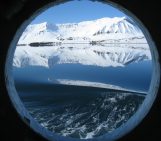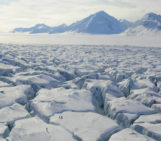
The latest climate models show that Arctic precipitation is changing more rapidly than previously projected with an earlier transition to a rainfall-dominated precipitation. This rapid change in precipitation will have huge implications for the Arctic ecosystem as well as those who live within the region.
Arctic precipitation change, why is it so important?
The rapid change in Arctic climate, from enhanced warming to rapid sea ice loss (see blog#1 or blog#2), is well known and understood. Alongside this is the understanding that precipitation in the Arctic will increasingly change in a warming world.
Previous studies have shown that precipitation in the Arctic will increase this century with more of this precipitation falling as rain rather than snow (Bintanja and Selten 2014). Of course, more precipitation may not be a bad thing, however the greater likelihood that it will fall as rain rather than snow in the Arctic of course is of high concern. This is because snow cover is very important in the energy balance of the atmosphere (as it reflects sunlight) keeping the atmosphere cool, which is obviously really important as our world continues to warm.
Our latest study has shown that these changes may be occurring much more rapidly than previously projected with a much earlier transition to a rainfall-dominated precipitation. In such a delicate ecosystem as the Arctic, more rapid changes in its climate will have large and significant consequences not only for those that live there, but globally.
Modelling the changes
To understand whether changes in precipitation are occurring more rapidly than previously projected in the Arctic, we analysed two different model datasets, namely CMIP6 and CMIP5. But what is CMIP?
CMIP stands for Coupled Model Intercomparison Project with CMIP5 being the fifth iteration and CMIP6 the sixth (and latest) iteration of this data. For each CMIP session, a number of different climate models are run and compared with each other by the scientific community involved in climate modeling. CMIP model projections are used in the different reports of the IPCC (Intergovernmental Panel on Climate Change) to get information about the future evolution of the Earth climate: CMIP5 models were used in the fifth assessment report (AR5), while CMIP6 models were used in the last report (AR6).
The future climate projections obtained from the models are based on a range of different scenarios which use several CO2 emission pathways but also a range of socio-economic factors such as population or land use change.
More rain, less snow

Figure 1: Total precipitation (red curves), rainfall (green curves) and snowfall (blue curves) for CMIP6 (solid line) and CMIP5 (dashed lines) change relative to the 1981-2010 climatology for autumn (September-November). The vertical blue and purple dashed lines denote the end of the historical period (on its left; 2005 for CMIP5 and 2014 for CMIP6), after which RCP8.5 and SSP5-8.5 climate scenarios start for CMIP5 and CMIP6, respectively. (Figure adapted from McCrystall et al., 2021).
In our study, we compared precipitation between the last two CMIP projects to reconcile whether the rate of change of the hydrological cycle in the Arctic was different in CMIP6 compared to CMIP5.
In line with other studies (Bintanja and Selten 2014, Bintanja and Andry 2017), we found that, in both datasets, the models projected an increase in Arctic total precipitation throughout the twenty-first century, which was largely due to increased rainfall throughout the century (Figure 1). In fact, the increases in precipitation in summer and autumn in this century are only from increased rainfall, as snowfall declines throughout this century in both seasons.
Through comparing the difference in end of the century (2090-2100) relative to the start of the century (2005-2014) between CMIP6 and CMIP5, we found that there was significantly more rainfall all across the Arctic, and in all seasons, in the latest CMIP6 projections compared to the previous CMIP5 (Figure 1).
We also found that not only will there be more rainfall in the Arctic in the future than previously projected, but that it will become the dominant form of precipitation earlier than projected too. In some seasons and regions, it would occur decades earlier. For example, in autumn (when the greatest changes of precipitation type and amount occur), in the central Arctic precipitation would transition from snow to rain around 2090/2100 according to CMIP5 models, while CMIP6 models show that this transition may actually occur around two decades earlier, around 2070 (Figure 2).

Figure 2: Decade of transition to a rain dominated precipitation in CMIP6 and CMIP5 in autumn (September – November) in the Arctic. (Figure adapted from McCrystall et al., 2021)
What is causing this increase in Arctic precipitation?
We found that a lot of these changes were due to higher temperatures, larger transport of moisture into the Arctic and lower sea ice cover. Indeed, with less sea ice and more transport of moisture to the Arctic, there is more water available in the atmosphere, thus translating to greater potential for precipitation. This, coupled with warmer temperatures, means that more precipitation will fall as rain rather than snow.
Why is this important?
Snowfall and snow cover currently dominate the Arctic environment. Any change to this will dramatically impact life in the Arctic. More rain on snow lead to aptly named ‘rain-on-snow’ events and can for example be devastating for muskoxen, caribou and reindeers (and their herders and those that depend on these animals). When a rain-on-snow event occurs, rain can settle on top of the snow or go within the snow pack, which followed by freezing temperatures can result in ice layers above or within the snow pack. This means that these animals have to use a lot of energy to try and break through the ice to forage between the snow and this can result in starvation and huge die off events.
Not only will the changes in Arctic precipitation be felt locally but these changes will also have a global reach. For example, changes in precipitation over Greenland will lead to more melt of Greenland glaciers and contribute to sea level rise. Considering that rainfall occurred at the highest station in Greenland (Summit) for the first time ever in recorded history last summer, does prove that precipitation changes are occurring, and occurring fast.
Changes in Arctic precipitation are concerning, but appropriate global climate action could limit the rate and amount of this change. Our study also found that if we can limit global warming to 1.5oC compared to pre-industrial levels (as was agreed in the Paris Agreement), then most of the Arctic would stay snowfall dominated. However, if we stay on course for a 3oC global warming, then most of the Arctic would become rainfall dominated and result in many negative effects as listed above (and outlined in more detail in the paper). This provides further context for the need to limit global warming and rapidly transition away from a fossil fuel dependant world as the impacts may also be worse than previously projected.
Further reading
- McCrystall et al. (2021) New climate models reveal faster and larger increases in Arctic precipitation than previously projected. Nature Communications 12:6765, DOI: 10.1038/s41467-021-27031-y.
- Serreze et al. (2021) Arctic rain on snow events: bridging observations to understand environmental and livelihood impacts. Environ. Res. Lett. 16:105009, DOI: 10.1088/1748-9326/ac269b/meta.
Edited by David Docquier and Giovanni Baccolo
 Michelle McCrystall is a Post-doc at the University of Manitoba in Winnipeg, Canada. Her research focuses on understanding current and future climate changes in the Arctic, specifically focusing on precipitation change. She also investigates remote teleconnections and the tropical drivers of climate and climate change in the Arctic. She tweets as @Michelle_McCrys; contact Email: michelle.mccrystall@umanitoba.ca.
Michelle McCrystall is a Post-doc at the University of Manitoba in Winnipeg, Canada. Her research focuses on understanding current and future climate changes in the Arctic, specifically focusing on precipitation change. She also investigates remote teleconnections and the tropical drivers of climate and climate change in the Arctic. She tweets as @Michelle_McCrys; contact Email: michelle.mccrystall@umanitoba.ca.



